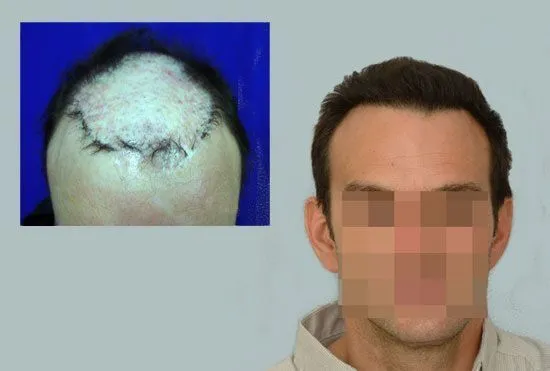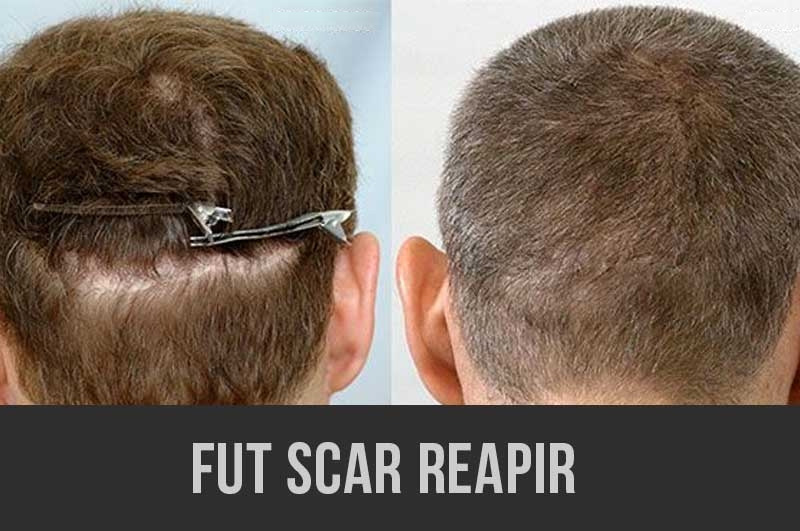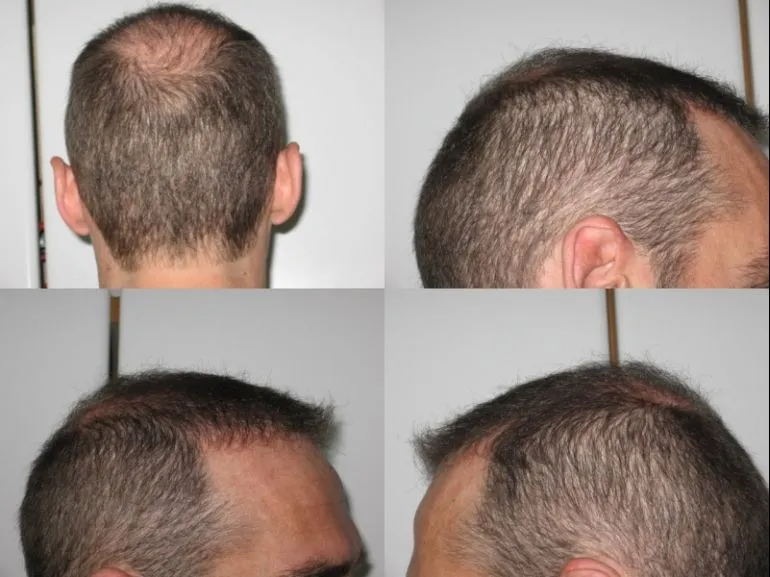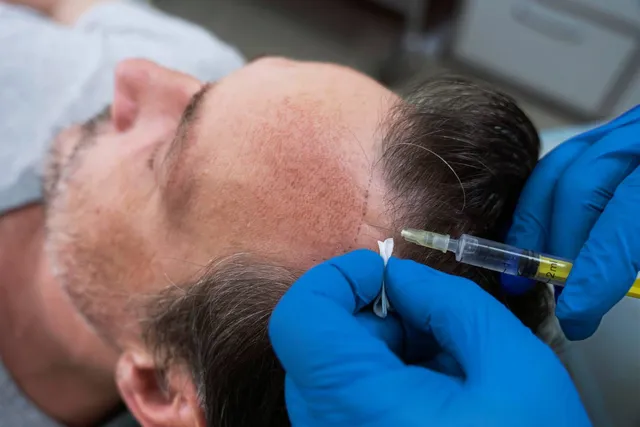WHY HAIR TRANSPLANT REPAIR?
Almost 40% of new Forhair patients seek reparative work. New advancements in hair transplant techniques allow us to correct bad hair restoration results, poor density, unnatural hairline design, scarring, and other mishaps from previous surgeries. Patients who select Forhair enjoy the results they sought in the first place.
Follicular Unit Transplantation (FUT) and other earlier procedures leave significant scarring. They also have other drawbacks -including a noticeable “plug” appearance. Still, other patients may be disappointed with FUE results from other clinics and are in need for hair transplant repair.
At Forhair we prioritize quality results and patient health. Cole Isolation Technique (CIT®), Dr. Cole’s groundbreaking improvement of FUE Hair Transplantation (Follicular Unit Extraction), is representative of this value. The technique emphasizes minimum invasiveness, leading to several important benefits:
- Miniscule Scarring - There is little to no scarring from CIT®, and any is easily correctable
- Density - CIT® has a success rate of 97%+
- Exactness - CIT® allows for precise accuracy, creating a natural hairline indistinguishable from any other
- Recovery - Minimum invasiveness allows for unprecedented recovery times -patients can return to work the very next day
Such strengths make CIT® particularly suitable for reparative procedures. Adherence to technique, however, is not enough. Hair transplant specialists must also know the fine points of reparative methods. Grafting a follicle transplant to scar tissue, for instance, is different than regular scalp tissue.

PLUG REDISTRIBUTIONS
Plug Redistribution is a procedure where the specialist repairs “plug” style transplants. Follicular Unit Transplants (FUT) and other old techniques leave a conspicuous “plug” style at the hairline. Current hair restoration specialists emphasize Follicular Unit Extraction (FUE) for this very reason.
However, the procedure only became prominent in the early 2000s. FUE also requires skill, leading to many specialists and patients electing for FUT or other procedures in the past fifteen years.
Plug-style transplants age. Though noticeable, hair plugs are initially dense and ensconced around regular follicles. Overtime patients can lose more hair, leading hair plugs to have an even more unnatural “doll’s hair” appearance. Larger plugs are more noticeable. All hair plugs, however, result from strip procedures.
Prior to FUE, the only ways to repair these cases were to cut out a “strip” across the hairline. This removes the “pluggy” appearance but also leaves a linear scar across the front of the head. Density is also not a guarantee as the linear scar is sometimes visible due to a sparse follicle count. Alternatively, specialists used a small punch to “dig” out the grafts -a crude method at best.
FUE can yield great-looking hairlines -if from a skilled surgeon. Proficiency in FUE, CIT®, and other techniques requires significant time investment and training. Offering FUE since 2003, Forhair is among the first hair restoration clinics to specialize in the procedure.
CIT® is particularly ideal for hair plug redistribution. Minimum invasiveness ensures minimal scarring. Precision, meanwhile, ensures a convincing hairline much like your original.
SCAR GRAFTING PROCEDURES
FUT transplants leave noticeable linear scars in donor spots. These scars may widen significantly, sometimes to disfiguring proportions. FUT (strip) scars can be distressing, potentially leading to low self-esteem and a disrupted lifestyle. There are a few reasons for this mishap, including an overly tight scalp, too low a graft placement, or poor surgical technique. Scars vary procedure by procedure. Some may be short while others will run from ear to ear. They often widen over time, occasionally to more than two centimeters – this can be noticeably deformative regardless of hair length.
Moderate hair length can usually conceal scars. Other times, though, they are apparent even with decent hair length. Scars can also change the direction of hair growth below the scar, relative to above the scar, which may cause a “shadow” of the linear scar to be evident even after hair somewhat grows out.
Those looking to correct their hair transplant scars had one option for many years -Scar Revision. It offers some chance of scar correction but is predominantly ineffective. The surgery involves removing the existing scar, with a scalpel, and closing the wound again with sutures or staples. Unfortunately, this method often results in a scar just as prominent, and sometimes even larger, than the original one.
Scars may be hard to “smooth over.” Through advances in hair transplantation methods and technology, though, attempts to camouflage scars are more successful than ever before. This new option makes Scar Revision less feasible than ever before.

SCAR GRAFTING, CIT®, AND BODY HAIR TRANSPLANTS
The best option is to avoid hair transplant scars but choosing to restore your hair with CIT® (Cole FUE). This is the best way to avoid any need for hair transplant repair. CIT® is precise enough to allow follicle-by-follicle transplantation into, and around, scar tissue. This effectively allows specialists to increase hair coverage -reducing scar noticeability and gaps in density.
Near anyone is a good candidate for CIT®. However, not all patients may have enough hair follicles in their donor spots. Body hair, in such cases, is also an option. Scalp hair tends to yield better and more consistent hair transplant results. Body hair grafts, meanwhile, are good for enhancing density.
At ForHair, patients can expect a growth yield of 80-95% for beard hair transplants, while chest hair transplants typically show a growth yield of around 60%.

CAMOUFLAGING LINEAR SCARS
Scar Grafting never requires density in areas around the scar. Instead, the objective is to effectively camouflage it. Further, follicles transplanted into scar regions might not yield like virgin scalp regions. The overall goal, though, is to add enough hair to break up the appearance of the scar. Additionally, more than one procedure is sometimes necessary to fully hide the scar.
Significant cosmetic change can require several months. The effects, though, are well worth undergoing several procedures. This typically adds enough hair to break up the appearance of the straight, shiny scar.
My hair is growing and seems to get thicker by the week. The hair in my scars is also growing! The hairline looks great and I could not be happier unless I grew all of my hair back.
DONOR RECHARGING
Available donor follicles and necessary coverage vary patient by patient. Hair loss severity and previous treatments both factor in viable donor hairs. Specialists always aim for density in recipient spots while preserving density in donor spots. Not achieving this balance can result in visibly thin spots in donor areas. There is a method that counteracts such thinness, though: Donor Recharging.
Donor Recharging is a method that transplants body hair to scalp donor spots. This enables partial donor replacement, adding greater density. Body hair does have a different texture than scalp hair. Transplanted correctly, though, and such grafts successfully camouflage themselves among scalp hair. They also add pigment to donor spots, further masking any “white spotting” that results from FUE.
CIT® is particularly suitable for Donor Recharging. The only FUE technique to leave stem cell remnants, CIT® offers a chance of hair follicles regenerating. The combination of CIT® and Donor Recharging maximizes the chance of convincing coverage in donor areas.
The effectiveness of Donor Recharging is noteworthy. This patient walked into Forhair with Norwood Class 6 hair loss. After the consultation, we decided to harvest 6,000 scalp grafts via CIT®. We then grafted a little more than 50% of the donor extraction sites with a CIT® Donor Recharging procedure. The patient can now wear his hair very short without any evidence of surgery. This hairstyle would not be a feasible option with strip methods, regardless of optimal scar healing.

Here are close-up images of one of the first patients to have a CIT® Donor Recharging procedure. We treated the auricular donor areas with CIT® donor recharging. A Norwood Class 6, he also needed a lot of donor hair to be able to reach his hair transplant goals. We harvested almost 20% of the existing hair in these auricular areas. Yet, even upon up-close examination, it seems completely natural. In this area, we placed body hair grafts in 90% of the scalp hair extraction sites using the CIT® donor recharging method.
HAIR TRANSPLANT REPAIR AND HAIR RESTORATION TREATMENTS
Forhair patients often receive hair restoration treatments. Those undergoing hair transplant repairs are particularly good candidates. Several treatments are particularly impressive and are the result of surgical wound generation. Others include at-home treatments with formulas to promote hair density and growth as well as overall scalp health.
CYTOKINE RICH PLASMA (CRP)
Among Forhair’s most recent advances, Cytokine Rich Plasma (CRP) is a drastic improvement over platelet-rich plasma (PRP). A serum that medical staff derives from the patient’s own blood, PRP has proven itself invaluable to surgical post-op. The reason is its level of cytokines and growth factors, both of which generate stem cell activity and regeneration.
Dr. Cole and Forhair researchers wondered if effectiveness pertains to the serum’s concentration. PRP is effective but much of its mass contains material the body will break down and consume rather than use.
By isolating effective cytokines and growth factors Forhair has increased PRP’s concentration by 6 to 8x. The serum leads to 99% growth within four and a half months. Many patients vastly prefer these quick results over waiting 12 months to see 100% growth.
ACELL
Like PRP, ACell is widely used in surgical post-op and hair transplant repair. A cellular matrix that adds structure to recovering wounds, ACell dramatically speeds the recovery process. It also helps prevent scarring, making it particularly ideal for CIT®. Significantly less prone to scarring, CIT® further benefits from ACell in post-op. The serum decreases scarring by 52% -even under a microscope.
While great for wound regeneration, ACell is also effective for growing hair. Applying it post-op leads to startlingly impressive results. Again, it is particularly ideal for CIT® or other minimally invasive procedures.
ACell adds important structures that stem cell remnants from donor sites can use to regenerate in full. Our patients enjoy an average of 130% to 140% greater hair density. This means for every 1000 grafts via CIT® plus ACell patients also have, on average, 300-400 donor follicles regenerate. Such a yield is exceptional as hair transplantats until now, has consisted of relocating follicles from one area of the head to another area. CIT® plus ACell is the first method to significantly boost hair count and enhance coverage in balding or thinning areas.
FORHAIR’S RANGE OF

Forhair prioritizes the patient’s best interests first. The incentive and groundwork for our expertise, hair transplant repair remains one of our most sought after skillsets. We show great sensitivity when assessing each case. We also take scarring seriously. Any Forhair patient with scarring from a Forhair procedure receives Scalp Micro Pigmentation free of charge. Look at more hair transplant repair results here and here.
The hair in my scars is also growing! The hairline looks great and I could not be happier unless I grew all of my hair back. Thank you for working on me and repairing Dr. Rossanelli’s mess I really do appreciate it
Repair Questions and Answers
The reversal of a hair transplant procedure is difficult. It is possible to remove the bad grafts and create a balding appearance. Once the grafts have been removed, accept your hair loss or rebuild transplant the area at a later date.
Repairing a botched hair transplant is not a scarless procedure. Though the extraction sites in a repaired area are very hard to detect with the naked eye when done by an experienced physician.
There are a few ways to fix a poor hair transplant. The best result will involve removing all the bad actors from the initial transplant. The second step would be to rebuild the transplant. Option two would consist of building in front of the bad hair transplant, camouflaging the pluggy grafts from before.
Hair transplant repair is not a painful procedure. There will be minor discomfort after the procedure. Over the counter pain killers will counter any discomfort.
There are a few methods available to cover a hair transplant scar. The easiest hair transplant option is grow your hair out. Another quick fix is to SMP (tattoo) the scar. SMP works really well by itself on FUE scars and small strip scars. If there is large scaring, consider scar grafting. Scar grafting is the best solution for filling in scars and can be combined with SMP to create a denser appearance that will conceal any distortion of pigment color from the previous procedure.

